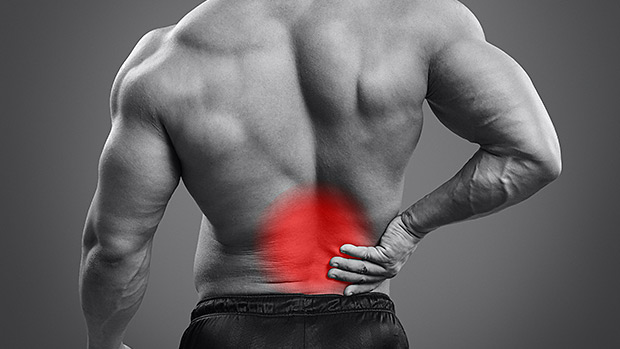Some back injures can be sudden and traumatic, but the majority of them just gradually sneak up on you. If you're dealing with minor tweaks and aches, you're going to need a prehab routine to do before workouts... and maybe even on off days. Your back will thank you.
Find The Culprit, Then Fight It
In general, nagging lower-back pain can be attributed to three things:
- Tight hip flexors
- A weak core
- Weak or tight glutes
Any one of these is bad on its own. If you have all three, your pelvis will get pulled forward causing an anterior pelvic tilt.
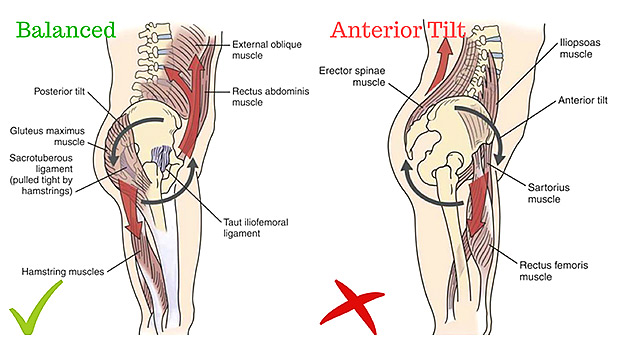
When this happens, you'll have significantly more stress on your lower back, not just while training, but all day long. This will cause your spinal erectors to constantly feel tight and sore.
To relieve the lower back, we need to release and lengthen the hip flexors, strengthen the core, and strengthen and lengthen the glutes.
Step 1: Release and Lengthen the Hip Flexors
For stretching to be maximally effective, start with some soft tissue work on the hip flexors.
Foam Ball Hip Flexor Release
Grab a moderate density foam ball to help relax the muscles and prepare them for the deeper release to come. You can find the right position for the ball by first locating your front hip bone – the anterior superior iliac spine (ASIS).
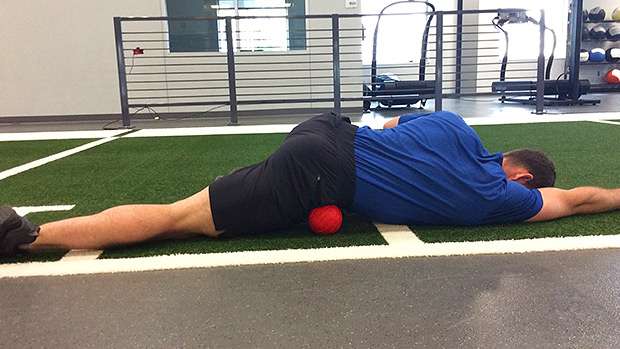
Once you locate this bony landmark, lie down on your stomach and place the ball just inside your ASIS. Spend about 30 seconds on each side while taking deep breaths to allow your hip flexors to relax and the ball to sink deeper.
Note: I'm using a "peanut" foam ball in the photo which has two balls fused together. The inner ball is hitting my hip flexors.
Although you can get a decent release from the ball alone, at some point you'll need to get deep into your hip flexors if they're really bound up. To do this, either buy a specialty tool designed to hit the hip flexors or be like MacGyver and create one out of the stuff you have handy.
Body Bar Hip Flexor Release

Try using a PVC pipe or Body Bar. If need be, cut a tennis ball in half and tape it to a Body Bar or PVC Pipe. The tennis ball on top allows the pressure to be smooth and uniform while protecting you from getting scratched by the edges of the pipe or Body Bar.
Once you have your tool ready, put the bottom of the bar against a wall and place the other end right next to your ASIS. Hinge at the hips and allow the bar to slowly press into your hip flexors.
Remember, you're not trying to impale your stomach on the bar. Think of going just inside the pelvis right next to the ASIS you located when doing the foam ball release. Once you've found the spot, hinge at the hips, and allow the bar to slowly press into your hip flexors.
Lengthen the Hip Flexors
Once you've successfully released the hip flexors, it's time to restore them from their shortened position. If you're training by yourself, try the kneeling oscillating hip flexor stretch.
Rotate your hips back while adding small oscillating rocking motions back and forth. You can also reach the same arm of the leg you're stretching across your body to get deeper into the hip flexor.
If you have a training partner and access to a table, you can also do the Thomas test stretch. To do this, lie down on a table and pull one knee into the chest while having your other leg hanging off the edge.
Thomas Test Stretch
Have your training partner press your knee downward and gently bend your knee by pushing on your ankle as you keep your lower back on the bench.
Step 2: Strengthen the Core
To strengthen your core, it's helpful to visualize your spine as a tower held up by guy-wires. To keep the tower (your spine) in a good position, you need to have your guy-wires (muscles) pulling evenly on the tower from the front, back, and sides.
If you're looking to create an ironclad core to protect your back, it's hard to beat Stuart McGill's "big three" – the curl up, the side plank, and the birddog. These exercises will fire up your deep core musculature and restore balance to your pelvis.
The Curl Up

Begin by lying on your back with one leg straight and the other bent to about 90 degrees. Place your hands under your lower back so you can feel your core engage during each rep.
Next, lift your chest slightly off the ground and focus on pressing your lower back into your hands so that your pelvis posteriorly rotates. This will activate your deep core muscles and will take pressure off your lower back. You should feel your lower back firmly press down onto your hands. Don't raise up so high that your lower back begins to round.
Keep your head neutral and look toward the ceiling. Tilting your chin to your chest will cause neck pain down the road. Aim for 3 reps with a 10-15 second hold at the top of each.
Side Plank
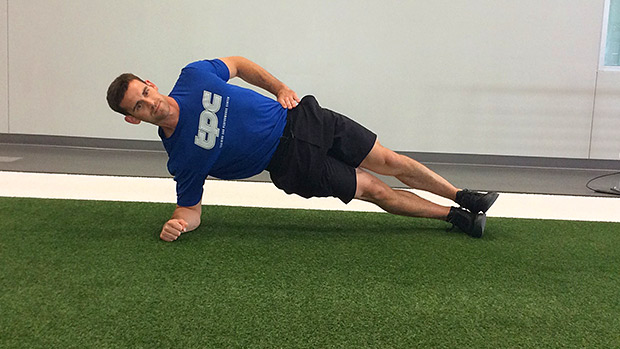
Begin by lying on your side with your knees bent and elbow stacked underneath your shoulder. Lift your hips and lock in your core so that only your feet and elbow are keeping your body suspended.
Try to hold this position for 10 to 20 seconds while preventing any movement from occurring in your lower back. Repeat for 2-3 rounds. To modify this movement, drop to your knees to the floor, or stagger your feet.
Bird-Dog
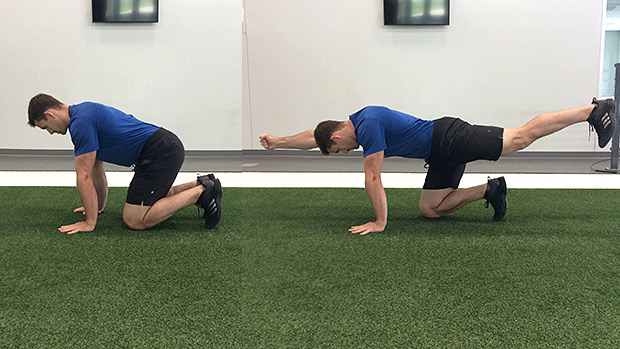
This can develop stability in the low back while allowing movement to occur at the hips and shoulder. Your spinal erectors, glutes, and hamstrings will be primarily worked.
Begin on all fours with your wrists stacked under your shoulders in a table-top position. Reach your opposite arm and opposite leg away from your body, allowing as little movement as possible to take place in your lower back.
Make a fist and squeeze everything as tightly as possible at the top of the movement to lock everything in and create whole-body tightness. Do 2-3 sets of 5 reps on each side with a 5 second hold at the top to lock every rep in.
Don't arch your lower back. The goal is to create a straight line running from your outstretched hand to your outstretched foot.
Step 3: Strengthen and Stretch the Glutes
Use the banded glute bridge and banded elevated clam shell as a precursor to your big compound lifts, or as a way to get your glutes fired up on your off days for general hip and back health.
Banded Glute Bridge
Begin by lying on your back with your legs bent at about 90 degrees. Have a band wrapped around both thighs, just above your knees.
Drive your knees out against the band and lift your hips towards the ceiling. Focus on driving through the heels of your feet to get better glute engagement. Squeeze your butt at the top of each rep. Maintain tension on the band for the entire set by continuing to drive your knees outward against the band.
Don't arch your back in an attempt to get your hips higher. Instead, focus on rotating your hips under (posterior pelvic tilt) at the top so you get better engagement of the glutes.
Do 2 sets of 5-10 reps and hold each rep at the top for 5 seconds.
Banded Hip Elevated Clam Shells
Begin by lying on your back with your legs bent, hips elevated, and a band wrapped around both thighs just above your knees. Drive your knees outward against the band and hold each rep for 5 seconds.
Focus on keeping your pelvis in a neutral position and don't overarch your back. Do 2 sets of 5-10 reps with a 5 second hold after each one.
Standing Pigeon Stretch
Once you've fired up your hips, you'll want to loosen them up so that they can move properly when you do your lower-body exercises. This is one way to do that.

Place one leg on a table with your knee bent. Have the other leg planted on the ground so that it looks like you're making a figure-4 with your legs.
Keep your chest tall, then hinge at the hips and lean forward if you'd like to deepen the stretch. Do small oscillations back and forth so that you find a spot that feels comfortable. You should feel a deep stretch through your glutes.

